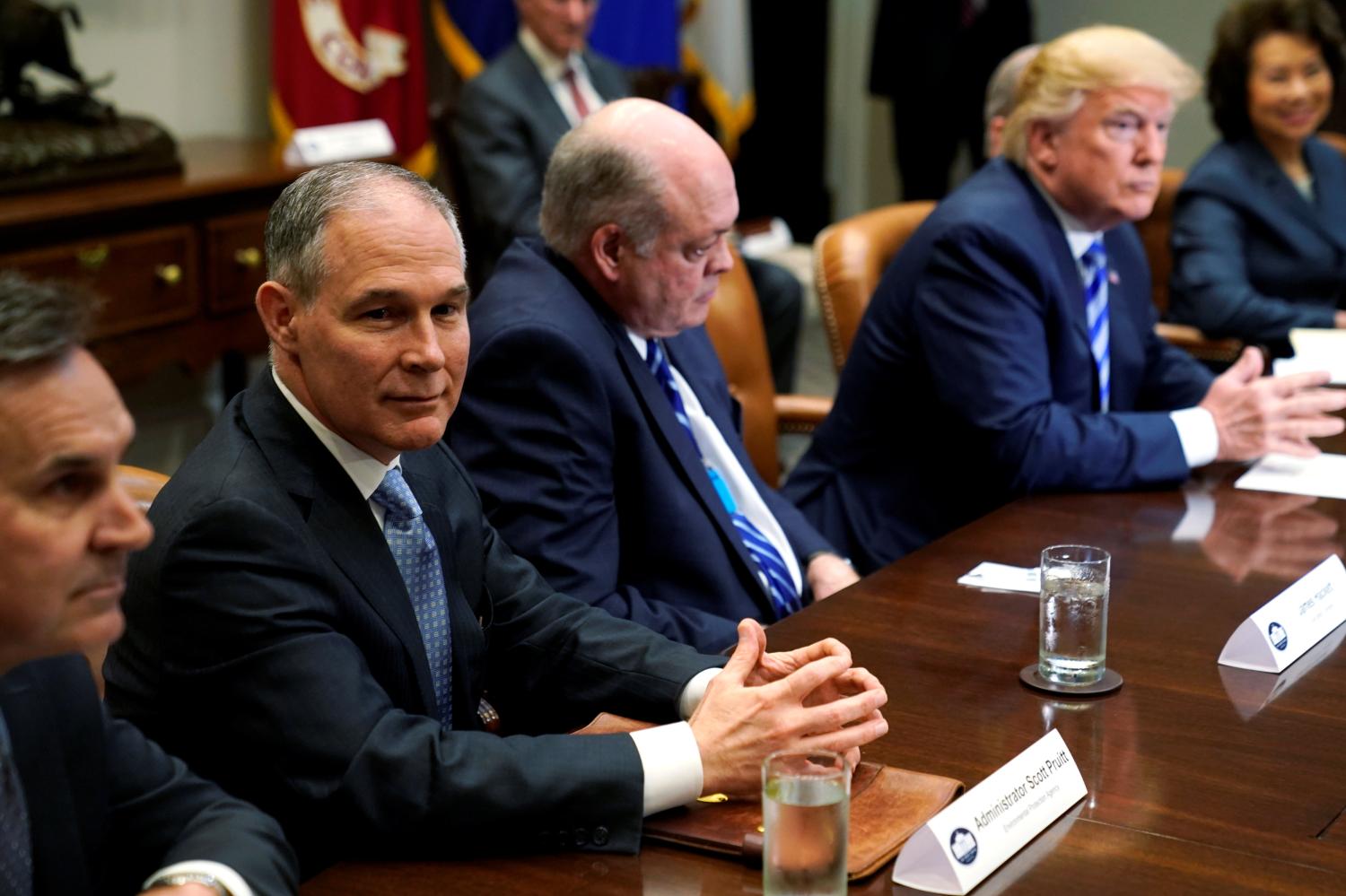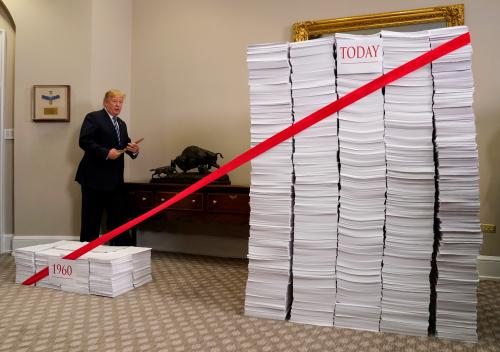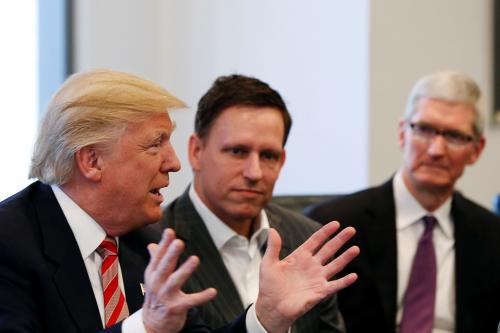This report is part of the Series on Regulatory Process and Perspective and was produced by the Brookings Center on Regulation and Markets.
Policymaking under the Trump administration seems to have become almost inexhaustibly confrontational. This very much includes the regulatory arena, where Trump appointees have brought new rulemaking nearly to a halt and have aggressively sought to reverse many Obama administration rules, often eliciting legal challenges. In this post, we show how confrontation has even found its way into the part of the rulemaking process that is supposed to be least controversial: direct final rulemaking. The trend we show illustrates one way in which opponents of the Trump administration have found to broaden their resistance into previously sleepy corners of regulatory practice.
What is direct final rulemaking?
Direct final rulemaking (DFR) is a technique for expediting the issuance of rules an agency believes will be noncontroversial. In a normal rulemaking proceeding, an agency first publishes a “Notice of Proposed Rulemaking” followed by a comment period in which interested parties may offer suggestions or criticisms of any kind. Only then does it go on to issue its final rule, at which point it must also address (though not necessarily heed) any substantial suggestions it received. DFR modifies these procedures such that the initial notice announces the prospective finalization of the rule after a comment period. If no “adverse comment” is received during that period, the rule is finalized without further notice.
If an adverse comment is received, however, the agency is compelled to withdraw the DFR and return to the normal notice-and-comment procedure. In other words, DFR is a way to dispense with one layer of formality when an agency thinks there is no need for it—when it wants to use the rulemaking form but sees doing so as the discharge of a routine function unlikely to attract criticism. Across administrations, the Environmental Protection Agency (EPA) is, by far, the most frequent promulgator of DFRs.
Increasing contestation
But it seems that even the smallest matters these days attract controversy, and, indeed, DFRs were contested more often than ever before in 2017. Although the Trump administration’s use of DFRs in 2017 was roughly in line with the late Obama administration, the portion of DFRs withdrawn after receiving adverse comments shot up. Out of 169 DFRs published in 2017, more than one-third (63) were withdrawn. The highest proportion ever previously withdrawn was 16 percent in 2001, with most years having a withdrawal rate between 5 and 10 percent.
To better understand what has changed, we examined all EPA DFRs that were ultimately withdrawn from three different years: 2005, 2009, and 2017.1 This includes 79 distinct DFRs: 12 from the George W. Bush administration in 2005, 6 from the Obama administration in 2009, and 61 from the Trump administration in 2017. In the vast majority of cases, when EPA withdraws a DFR it proceeds to nevertheless finalize the rule through the normal rulemaking process. But not always: 11 rules were apparently never finalized (1 Bush, 2 Obama, and 8 Trump).2
For the rules that were finalized, we have 215 total comments—an average of around three per rule. But the distribution is quite uneven; 12 dockets, all but one from the Trump administration, had five or more comments, and three from 2017 had more than 10 (13, 17, and 21).
Most comments have no name of any kind attached to them, as the regulations.gov website does not require one. Many others have names with no further identifying information. Of the few dozen cases where DFR commenters clearly reveal their affiliations, most (24) are representatives of regulated industries, some (9) are identifiable environmentalists of various sorts, and some (7) come from other categories, such as local government officials.
What do commenters want, and how does EPA respond?
The quality of comments on EPA’s DFRs varies enormously, from commenters who want to register their general disapproval of the agency’s leadership (or the president) to those who are well-informed about a rule’s details and seek some particular change. Not surprisingly, the agency responds very differently depending on the seriousness of the comment.
To illuminate this difference, we coded each comment on a three-point quality scale, with 1 indicating a comment with little bearing on the rule in question (“spam”), 2 indicating some familiarity, and 3 indicating a solid knowledge of the rule’s contents. Table 1 shows the distribution of these three types across the three different administrations.
| Table 1. DFR comment quality for comments addressed by EPA, by administration | |||
|---|---|---|---|
| 1 – Spam/Unrelated | 2 – Some Familiarity | 3 – Knowledgeable | |
| George W. Bush | 8 | 3 | 11 |
| Barack Obama | 2 | 1 | 1 |
| Donald Trump | 96 | 58 | 35 |
Although this oversimplifies things somewhat, we propose three ideal types of commented-on DFRs that give a general sense of what is going on.
1. Sand in the gears
Sometimes, the story seems as simple as one citizen making use of the power to comment on a DFR as a way to annoy the administration—especially the current one. Mostly, they do so anonymously, and with no indication that they are familiar with the details of the rule in question. Occasionally this can be rather amusing. For example, one anonymous commenter on EPA-HQ-OAR-2017-0213, “Protection of Stratospheric Ozone: Refrigerant Management Regulations for Small Cans of Motor Vehicle Refrigerant,” offers a riff on a classic Cole Porter tune. “Miners do it, oilmen do it / Coz they’re thinking about Scott Pruitt / Let’s do it. Let’s trash the land.” Others offer rather less colorful insults of Pruitt or the president. Some conclude: “#resist”. Some seem earnestly desperate: “Please do not repeal or defund the EPA.” One comment reads, in full: “bad idea.” Slightly more than half of the comments on DFRs in 2017 fit this mold.
These sorts of commenters could not possibly imagine they are constructively contributing to better policy. But by offering adverse comments on DFRs they do create at least a small headache for agency personnel, which perhaps they imagine makes it less likely that the EPA will be able to take some other step they dislike.
Although the agency does have to go through the trouble of a normal proposal and finalization, this is most often a sort of box-checking exercise.
Quite unsurprisingly, EPA’s response to such comments is to treat them as minor bumps in the road. The standard approach during the Bush and Obama years examined was to give cursory dismissals of the adverse comments in the final rule. In 2017, however, the Trump administration stopped doing even that. The agency did not bother to refer specifically to most low-quality as it proceeded to a normal final rulemaking. Of 96 low-quality comments, just 14 received specifically-targeted responses (none of which were favorable). Although the agency does have to go through the trouble of a normal proposal and finalization, this is most often a sort of box-checking exercise.
The agency is only somewhat more receptive to commenters who show limited familiarity with a rule. Out of the 58 middling-quality comments on DFRs received in 2017, EPA did not reference 12 and rejected 36. Of the remainder, EPA affirmed 3 and had a “complicated” response to 7.
2. Belated consultation
In a number of cases, a knowledgeable commenter seeks to alter a rule rather than block it and offers a clear idea about how a rule should be altered. Commenters sometimes suggest specific changes to regulatory language, clarifications, exceptions, technical corrections, or changes to applicability dates. In many cases, EPA simply takes the suggested changes on board. The best understanding of such actions is that EPA is being informed by a consultation that would have more conveniently happened before publication of the DFR. The need to work through the standard process is a hassle, but presumably both the agency and the commenter end up satisfied.
The Trump administration explicitly accepted about half (16 of 35) of the high-quality comments they received on DFRs, most of which came from recognizable industry groups (and some of which were basically expressions of support). However, in a few cases, it also acknowledged concerns raised by environmental commenters and amended its proposals accordingly.
3. Misguided use of the DFR format
In a few cases, the high number of comments a DFR elicited suggests that the form probably was inappropriately used. The clearest case is probably EPA’s extension of the compliance date for formaldehyde emission standards for composite wood products (EPA-HQ-OPPT-2017-0244), which received 9 comments, seven of which were high quality. In this case and a few others, the number of concerns submitted after the publication of the DFR suggests that the matter was probably too controversial to fit the DFR model.
It should be said that in some instances, it is not at all clear what led to a high volume of comments. The DFR in our sample that received the most comments was an approval of Rhode Island’s enhanced motor vehicle inspection and maintenance plan in 2017. Of the 21 comments received, only six were clearly cognizant of the rulemaking’s content and only three showed even limited knowledge of it. Many resemble the incoherent spam pastiches that sometimes find their way into our inboxes, raising the question of whether some people might be programming bots to submit comments. So volume, in itself, is not indicative of genuine controversy.
A turn away from DFRs in 2018?
Given the hassle that DFR commenters often created in 2017, might the EPA and other agencies decrease their use of the procedure in 2018 and beyond? We have not performed a full analysis of available data, but a brief preliminary look lets us offer a cautious “maybe.”
It is possible, then, that the Trump administration has moved away from DFRs, judging that this means of streamlining noncontroversial actions is no longer effective in our age of ubiquitous controversy.
As of September 26, our search indicates that agencies have published only 45 direct final rules in 2018—a seemingly steep drop from the pace in 2017, when 169 DFRs were published. Of those 45, 8 have been withdrawn—which is still a high proportion relative to the historic norm. EPA has published just 23 DFRs, and withdrawn 7. It is possible, then, that the Trump administration has moved away from DFRs, judging that this means of streamlining noncontroversial actions is no longer effective in our age of ubiquitous controversy.
But this is a preliminary suggestion that must be accompanied by a serious caveat, which is that at this point in 2017, there were just 10 withdrawn DFRs. An additional 53 were withdrawn in October through December. It is unclear to us why this activity would have piled up late in the year, but perhaps there is some seasonal aspect to DFR activity and the trend will repeat itself in 2018. (Publication of DFRs did not show any clear seasonal trend in 2017; by this point in the year, there were 124 DFRs published.) We may also be facing some novel data complication in 2018, although this is unlikely.
Conclusion
The story of DFRs we present here is not, in itself, hugely important. The whole point of DFRs is that they provide an outlet for noncontroversial matters, generally deep in the regulatory weeds and far from the headlines. This stuff is supposed to be boring.
And yet, during the Trump administration, conflict has seeped into even this sleepy corner. More than a third of Trump administration DFRs received adverse comment, including a huge rise in totally unconstructive spam comments. This may have significantly diminished the value of direct final rulemaking for the Trump administration, which has apparently cut back its use of the procedure in 2018. The episode thus illustrates just how conflictual American policymaking has become. We will have to wait and see whether this change is permanent or merely a symptom of a particularly heated political moment.
-
Footnotes
- Since it was the first year of the first George W. Bush administration, 2001 would have made a better point of comparison, but data limitations made this prohibitively difficult, and so we used the first year of Bush’s second term instead.
- This count may be inflated for the Trump administration because of time censoring; we conducted our search in early September 2018.






